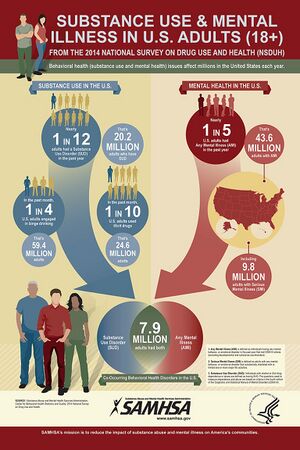Substance Use Disorder
Original Editor - Lucinda hampton
Top Contributors - Lucinda hampton
Introduction[edit | edit source]
Substance use disorders (SUD) involve excessive use of nicotine, alcohol, and other illicit substances that leads to social, academic, and occupational impairment. The most common illicit substances seen include cannabis, marijuana, cocaine, narcotic painkillers, intraveneous drug abuse, inhalants, opioids, anabolic steroid abuse and stimulants. The specific factors of substance use disorder consist of abuse, intoxication, and physical/psychological dependence. [1]
A person who is diagnosed with a SUD uses a particular substance regularly. Over time, they may build up tolerance ie they need to take larger amounts of something in order to get the same effect. The person may spend a lot of time thinking about how they can get it and how they can get money to pay for it.
SUD can also cause problems with personal care and physical health. It may put pressure on relationships and cause financial stress. It can also lead to changes in mood or behaviour, such as increased aggression or irritability, depression and lethargy.[2]
Etiology and Epidemiology[edit | edit source]
The cause of SUDs is multifactorial and includes psychological, biological, socio-cultural, and environmental factors. Co-morbid psychiatric disorders have been associated with an increased risk of illicit substance use. eg attention deficit hyperactivity disorder (ADHD) dan bipolar affective disorders (both having an increased risk of developing a substance use disorder in adulthood compared to the general population).[1]Adverse childhood experiences (ACEs) have been strongly linked with subsequent substance use. [3]
- Around 1 in 20 Australians has an addiction or substance abuse problem. It can result in changes and long-term damage to the brain and other organs. Substance abuse is a major cause of mental illness. [4] SUDs are among the most common of mental health disorders experienced by young people. In Australia, 12.7% of people aged 16-24 are estimated to have a SUD, with higher rates among young men than young women (16% of males, 10% of females). Harmful use of alcohol was the most commonly reported substance use disorder (appox. 9%)[5].
- Recent findings reveal that the U.S. youth lifetime lifetime prevalence of: alcohol use disorders is approx. 8%; illicit drug use disorders is 2–3%. The striking increase in prevalence rates from ages 13 to 18 highlight adolescence as the key period of development of substance use disorders.[6]
Why SUDs occur[edit | edit source]
According to the National Institute on Drug Abuse, people begin taking drugs for a variety of reasons, including:
- To feel good — feeling of pleasure, “high” or "intoxication"
- To feel better — relieve stress, forget problems, or feel numb
- To do better — improve performance or thinking
- Curiosity and peer pressure or experimenting
In addition to substances, people can also develop addiction to behaviours, eg gambling disorder.[7]
COVID 19 Effects[edit | edit source]
The closures of businesses and states throughout the U.S. due to the COVID-19 pandemic have been stressful, costly and challenging for many.
But the restrictions do not affect everyone equally. Particularly vulnerable are those with substance use disorders. With schedules disrupted, medical and psychological care curtailed and support networks shut down, the COVID-19 pandemic may jeopardize their recovery.[8]
Symtoms[edit | edit source]
Symptoms fall in 4 main categories:
- Impaired control: a craving or strong urge to use the substance; desire or failed attempts to cut down or control substance use
- Social problems: substance use causes failure to complete major tasks at work, school or home; social, work or leisure activities are given up or cut back because of substance use
- Risky use: substance is used in risky settings; continued use despite known problems
- Drug effects: tolerance (need for larger amounts to get the same effect); withdrawal symptoms (different for each substance)
Many people experience substance use disorder along with another psychiatric disorder. Oftentimes another psychiatric disorder precedes substance use disorder, or the use of a substance may trigger or worsen another psychiatric disorder.[7]
Treatment[edit | edit source]
Many treatment options are available for addictions and substance abuse, ranging from counselling through to hospital treatment depending on which substance is involved and seriousness of the dependence.
- Mild substance abuse can be treated with simple counselling and lifestyle changes. Severe dependence on substances like alcohol or heroin may require treatment in a hospital.
- Detoxification means stopping intake of the substance and having medical treatment until the substance has cleared from the bloodstream.
- Rehabilitation (going to ‘rehab’) refers to longer-term treatment, which may occur in a residential clinic or at home. This often involves psychological treatments to address any underlying issues that may have caused the initial substance abuse, such as childhood trauma, anxiety or depression.
- Cognitive behavioural therapy (CBT) for substance use disorders has demonstrated efficacy as both a monotherapy and as part of combination treatment strategies. These interventions have demonstrated efficacy in controlled trials and may be combined with each other or with pharmacotherapy to provide more robust outcomes[9]
For people who have a substance use disorder and a mental illness, treatment needs to address both conditions at the same time to be effective[4].
Physiotherapy[edit | edit source]
Physiotherapists can use their skills to promote physical activity in people with SUD. This would ideally exist within a multidisciplinary setting. See Mental Health, Physical Activity and Physical Therapy
- Strong evidence exists showing physical exercise can be an effective adjunct treatment method for abstinence from alcohol, nicotine, and illicit drugs in abusers. Physical exercise not only increases the abstinence rate in subjects with SUD, but also eases withdrawal symptoms, anxiety, and depression symptoms. The treatment effects of physical exercise in these four aspects verify that physical exercise guidance by the American College of Sports Medicine (ACSM) is an effective means for drug abstinence. Additionally, mind-body exercises (including Tai Chi and Yoga) have similar treatment effects as to aerobic exercise.
- Physical exercise has been proven effective in facilitating drug abstinence, however the effects on alcohol, nicotine and illicit drug abusers are different. The effects of physical exercise on illicit drugs abusers are significantly greater compared to the others[10].
References[edit | edit source]
- ↑ 1.0 1.1 Jahan AR, Burgess DM. Substance Use Disorder. Updated 8.18.21 Available: https://www.statpearls.com/ArticleLibrary/viewarticle/131342 (accessed 28.8.2021)
- ↑ NSW Health Substance Abuse Disorder Available: https://www.health.nsw.gov.au/mentalhealth/psychosocial/foundations/Pages/types-substance.aspx (accessed 28.8.2021)
- ↑ Shin SH, McDonald SE, Conley D. Patterns of adverse childhood experiences and substance use among young adults: A latent class analysis. Addictive behaviors. 2018 Mar 1;78:187-92.Available:https://pubmed.ncbi.nlm.nih.gov/29179155/ (accessed 29.8.2021)
- ↑ 4.0 4.1 Health Direct Substance Abuse Available:https://www.healthdirect.gov.au/substance-abuse (accessed 28.8.2021)
- ↑ Head space SUDs Available: https://headspace.org.au/health-professionals/information-and-guidelines/understanding-substance-abuse-for-health-professionals/(accessed 28.8.2021)
- ↑ Merikangas KR, McClair VL. Epidemiology of substance use disorders. Human genetics. 2012 Jun 1;131(6):779-89.Available:https://www.ncbi.nlm.nih.gov/pmc/articles/PMC4408274/ (accessed 28.8.2021)
- ↑ 7.0 7.1 Pyschiatry Org What is a SUD Available: https://www.psychiatry.org/patients-families/addiction/what-is-addiction (accessed 28.8.2021)
- ↑ The Conversation People with substance use disorders face greater challenges during the COVID-19 pandemic Available:https://theconversation.com/people-with-substance-use-disorders-face-greater-challenges-during-the-covid-19-pandemic-137476 (accessed 29.8.2021)
- ↑ Waldron HB, Kaminer Y. On the learning curve: the emerging evidence supporting cognitive–behavioral therapies for adolescent substance abuse. Addiction. 2004 Nov;99:93-105.Available:https://pubmed.ncbi.nlm.nih.gov/15488108/ (accessed 29.8.2021)
- ↑ Wang D, Wang Y, Wang Y, Li R, Zhou C. Impact of physical exercise on substance use disorders: a meta-analysis. PloS one. 2014 Oct 16;9(10):e110728.Available:https://www.ncbi.nlm.nih.gov/pmc/articles/PMC4199732/ (accessed29.8.2021)












